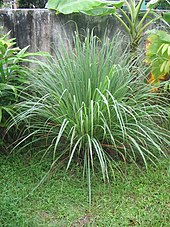Lemongrass oil
Lemongrass oil (also: Citronengrasöl and lemongrass oil , lat. Cymbopogonis citrati aetheroleum , engl. Lemon grass oil ) is a light yellow to orange yellow essential oil . The oil exudes a fresh and strong lemon-like smell with a sharp-bitter, herbaceous, leaf-like fragrance component. Fresh lemongrass oil is extremely light-sensitive and soluble in ethanol, although the solubility can decrease with storage time.
Manufacturing
By steam distillation from the tropical grasses Cymbopogon flexuosus (East Indian lemongrass oil) or from Cymbopogon citratus (West Indian lemongrass oil). The main growing area for the East Indian species is India, for the West Indian species Central and South America.
Chemical ingredients
| safety instructions | |||||||||
|---|---|---|---|---|---|---|---|---|---|
| Surname |
Lemongrass oil |
||||||||
| CAS number |
89998-14-1 |
||||||||
|
|||||||||
The main ingredient is citral (70–75%), (geranial, neral, dipenten , farnesol, etc.).
Effect and use in medicine
Lemongrass oil has an antibacterial and sedative effect . Lemongrass oil is used internally for inflammatory diseases in the gastrointestinal tract and in the biliary tract . Externally, the oil is used as a hyperemic agent for lumbago , sprains and diseases of the rheumatic type.
Use in technology
Today, lemongrass oil is mainly used to perfume household items (e.g. soap). In the past, lemongrass oil was also used to extract citral. Because of the competition from both the synthetically produced citral and the Litsea cubeba oil as well as other natural citral sources, the importance of lemongrass oil has declined sharply in recent decades. The world annual production is approx. 1,000 tons.
Hazards
There is an allergy potential, but it is much lower than with other terpenes . Due to photodermatitis and possible skin sensitization effects, lemongrass oil should not be used on the skin (or only very diluted) .
literature
- Hermann PT Ammon et al .: Hunnius Pharmaceutical Dictionary . 9th edition, Walter de Gruyter Verlag , Berlin - New York, 2004, ISBN 3-11-017475-8 geb. and ISBN 3-11-017487-1 brosch.
- Römpp Lexicon Natural Products . Georg Thieme Verlag , Stuttgart - New York, 1997, ISBN 3-13-749901-1 , p. 359.
Individual evidence
- ↑ Baby P. Skaria: Aromatic Plants . New India Publishing, New Delhi 2007, ISBN 978-81-89422-45-5 , pp. 103 ( limited preview in Google Book search).
- ^ Horst Surburg, Johannes Panten: Common Fragrance and Flavor Materials: Preparation, Properties and Uses . John Wiley & Sons, p. L. 2016, ISBN 978-3-527-69318-4 ( limited preview in Google Book Search).
- ↑ a b Lemon Grass Oil Organic data sheet at aromantic.co.uk, accessed on June 11, 2016 (PDF; 429 kB).
- ↑ Baby P. Skaria: Aromatic Plants . New India Publishing, New Delhi 2007, ISBN 978-81-89422-45-5 , pp. 95 ( limited preview in Google Book search).








